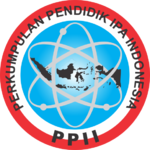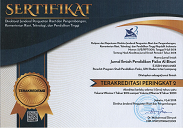Physics Concepts Based Data Centre Operations: A Medium for Education on Energy Efficiency and Technological Innovations
Abstract
Data centres are considered the exclusive sites of information technology and computer science. However, many aspects of their day-to-day operation can be used to teach important concepts in physics, such as heat transfer, AC and DC power transmission, fibre optic transmission, energy loss in transmission cables, and electronic componentry. Data processing requirements and power usage in data centres are growing exponentially, and therefore, solutions need to be developed to reduce energy costs, given the challenges of global warming. To this end, work is being done on storing data in strands of DNA. An experiment to measure the change in temperature of air passing through an internet hub is described as a means of teaching students about the physics of data centres. The procedure and calculations shown in this particular experiment can be used and applied by secondary school physics students to evaluate the energy budget and efficiency of different data centres, such as those used at their school. In addition, this article details how students can make simple calculations that directly show how novel DNA data storage technology can be utilized to reduce the amount of hardware and power used at data centres. The potential for quantum computing to reduce the power requirements of data centres is also discussed.
Keywords
Full Text:
PDFReferences
Apata, G., Adebayo, A., & Ainah, P. K. (2022). Transmission Losses in Power Systems: An Overview, Proceeding of the 1st ICEECE & AMF (2021), 1-6. https://www.researchgate.net/publication/361094202_Transmission_Losses_in_Power_Systems_An_Overview
Chen, S. (2023). Are quantum computers really energy efficient?’, Nat Comput Sci 3, 457–460. https://doi.org/10.1038/s43588-023-00459-6
Dong, Y., Sun, F., Ping, Z., Ouyang, Q., Qian, L. (2020). DNA storage: research landscape and future prospects’, National Science Review, 7 (6), Pages 1092–1107, https://doi.org/10.1093/nsr/nwaa007
Fitzgerald, B.W., Emonts, P., Tura, J. (2024). A Christmas story about quantum teleportation’, Phys. Educ.Vol. 59 (3) Pages 035021. DOI: 10.1088/1361-6552/ad2cf4 https://dx.doi.org/10.1088/1361-6552/ad2cf4
Globus, N. and Blandford, R.D. (2020). The Chiral Puzzle of Life’, The Astrophysical Journal Letters. Vol. 895(1), DOI: 10.3847/2041-8213/ab8dc6.
Hughes, C., Isaacson, J., Turner, J., Perry, A., Sun, R. (2022). Teaching Quantum Computing to High School Students’, Phys. Teach. 60 (3): 187–189. https://doi.org/10.1119/10.0009686
James, G. (2012), Power, pollution and the internet, The New York Times. https://www.nytimes.com/2012/09/23/technology/data-centers-waste-vast-amounts-of-energy-belying-industry-image.html
Jones, N. (2018). How to stop data centres from gobbling up the world's electricity’, Nature, 561(7722):163-166. doi: 10.1038/d41586-018-06610-y. PMID: 30209383.
Krijtenburg-Lewerissa, K., Pol, H.J. Brinkman, A., van Joolingen, W.R. (2017). Insights into teaching quantum mechanics in secondary and lower undergraduate education’, Physical Review Physics Education Research 13 (1) Pages 010109 DOI:10.1103/PhysRevPhysEducRes.13.010109 https://link.aps.org/doi/10.1103/PhysRevPhysEducRes.13.010109
Lee, T. (2021). Scaling renewable energy technologies:Challenges and opportunities. Urban Energy Journal, 5(3), 89-101
LightEdge. (2023). The Data Explosion and Hidden Data Storage Costs in the Cloud – Could Object Storage Be the Answer? https://www.lightedge.com/blog/the-data-explosion-and-hidden-data-storage-costs-in-the-cloud-could-object-storage-be-the-answer/#:~:text=Recent%20research%20forecasts%20a%2022,of%20stored%20data%20in%202020.
Meyer, J.C., Pollock, S.J., Wilcox, B.R., Gina Passante, G. (2023). How Media Hype Affects Our Physics Teaching: A Case Study on Quantum Computing’. Phys. Teach. 61 (5): 339–342. https://doi.org/10.1119/5.0117671
Riera Aroche, R., R., Ortiz Garcia,Y.M., Martínez Arellano, M.A., Riera Leal, A. (2024). DNA as a perfect quantum computer based on the quantum physics principles’, Sci Rep 14, 11636. https://doi.org/10.1038/s41598-024-62539-5
Ryan, St. (2023). Exponential data growth could turn storage for AI into an information supply chain, Silicon Angle. https://siliconangle.com/2023/08/03/exponential-data-growth-could-turn-storage-for-ai-into-an-information-supply-chain-ibmstoragesummit/
Sallon, S., Solowey, E., Cohen, Y., Korchinsky, R., Egli, M., Woodhatch, I., Kislev, M. (2008). Germination, Genetics, and Growth of an Ancient Date Seed. Science, 320(5882), 1464–1464. doi: 10.1126/science.1153600
Singh, C., Levy, A., Levy, J. (2022). Preparing Precollege Students for the Second Quantum Revolution with Core Concepts in Quantum Information Science’. Phys. Teach. 60 (8): 639–641. https://doi.org/10.1119/5.0027661
Shankland, S. (2019). Startup packs all 16GB of Wikipedia onto DNA strands to demonstrate new storage tech - Biological molecules will last a lot longer than the latest computer storage technology, Catalog believes’. CNET. Retrieved 15 February 2024.
Thoroughbrednews, 13 November 2023 https://www.thoroughbrednews.com.au/news/story/biggest-melbourne-cup-carnival-in-years-158543?section=industry#:~:text=It%20was%20also%2010%20Play's,audience%20increasing%2035%25%20on%202022.
Wehner, S., Elkhous, D., Hanson, R. (2018). Quantum internet: A vision for the road ahead’, Science, 362(6412), 1-9. 10.1126/science.aam9288
Willers, H., Dahm-Daphi, J. and Powell, S. (2004). Repair of radiation damage to DNA, British Journal of Cancer. 90(7), 1297–1301. https://doi.org/10.1038/sj.bjc.6601729
Yiming Dong, Fajia Sun, Zhi Ping, Qi Ouyang, Long Qian. (2020). DNA storage: research landscape and future prospects, National Science Review, 7(6), 1092–1107, https://doi.org/10.1093/nsr/nwaa007.
DOI: http://dx.doi.org/10.24042/jipfalbiruni.v13i2.24480
Refbacks
- There are currently no refbacks.

Jurnal ilmiah pendidikan fisika Al-Biruni is licensed under a Creative Commons Attribution-ShareAlike 4.0 International License.
![]()







